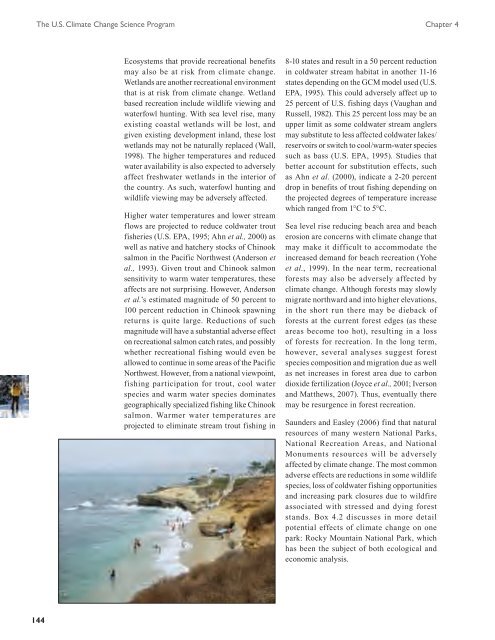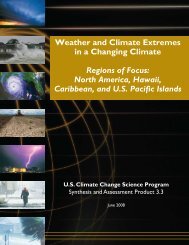Analyses of the Effects of Global Change on - US Climate Change ...
Analyses of the Effects of Global Change on - US Climate Change ...
Analyses of the Effects of Global Change on - US Climate Change ...
Create successful ePaper yourself
Turn your PDF publications into a flip-book with our unique Google optimized e-Paper software.
The U.S. <strong>Climate</strong> <str<strong>on</strong>g>Change</str<strong>on</strong>g> Science Program Chapter 4<br />
144<br />
Ecosystems that provide recreati<strong>on</strong>al benefits<br />
may also be at risk from climate change.<br />
Wetlands are ano<str<strong>on</strong>g>the</str<strong>on</strong>g>r recreati<strong>on</strong>al envir<strong>on</strong>ment<br />
that is at risk from climate change. Wetland<br />
based recreati<strong>on</strong> include wildlife viewing and<br />
waterfowl hunting. With sea level rise, many<br />
existing coastal wetlands will be lost, and<br />
given existing development inland, <str<strong>on</strong>g>the</str<strong>on</strong>g>se lost<br />
wetlands may not be naturally replaced (Wall,<br />
1998). The higher temperatures and reduced<br />
water availability is also expected to adversely<br />
affect freshwater wetlands in <str<strong>on</strong>g>the</str<strong>on</strong>g> interior <str<strong>on</strong>g>of</str<strong>on</strong>g><br />
<str<strong>on</strong>g>the</str<strong>on</strong>g> country. As such, waterfowl hunting and<br />
wildlife viewing may be adversely affected.<br />
Higher water temperatures and lower stream<br />
flows are projected to reduce coldwater trout<br />
fisheries (U.S. EPA, 1995; Ahn et al., 2000) as<br />
well as native and hatchery stocks <str<strong>on</strong>g>of</str<strong>on</strong>g> Chinook<br />
salm<strong>on</strong> in <str<strong>on</strong>g>the</str<strong>on</strong>g> Pacific Northwest (Anders<strong>on</strong> et<br />
al., 1993). Given trout and Chinook salm<strong>on</strong><br />
sensitivity to warm water temperatures, <str<strong>on</strong>g>the</str<strong>on</strong>g>se<br />
affects are not surprising. However, Anders<strong>on</strong><br />
et al.’s estimated magnitude <str<strong>on</strong>g>of</str<strong>on</strong>g> 50 percent to<br />
100 percent reducti<strong>on</strong> in Chinook spawning<br />
returns is quite large. Reducti<strong>on</strong>s <str<strong>on</strong>g>of</str<strong>on</strong>g> such<br />
magnitude will have a substantial adverse effect<br />
<strong>on</strong> recreati<strong>on</strong>al salm<strong>on</strong> catch rates, and possibly<br />
whe<str<strong>on</strong>g>the</str<strong>on</strong>g>r recreati<strong>on</strong>al fishing would even be<br />
allowed to c<strong>on</strong>tinue in some areas <str<strong>on</strong>g>of</str<strong>on</strong>g> <str<strong>on</strong>g>the</str<strong>on</strong>g> Pacific<br />
Northwest. However, from a nati<strong>on</strong>al viewpoint,<br />
fishing participati<strong>on</strong> for trout, cool water<br />
species and warm water species dominates<br />
geographically specialized fishing like Chinook<br />
salm<strong>on</strong>. Warmer water temperatures are<br />
projected to eliminate stream trout fishing in<br />
8-10 states and result in a 50 percent reducti<strong>on</strong><br />
in coldwater stream habitat in ano<str<strong>on</strong>g>the</str<strong>on</strong>g>r 11-16<br />
states depending <strong>on</strong> <str<strong>on</strong>g>the</str<strong>on</strong>g> GCM model used (U.S.<br />
EPA, 1995). This could adversely affect up to<br />
25 percent <str<strong>on</strong>g>of</str<strong>on</strong>g> U.S. fishing days (Vaughan and<br />
Russell, 1982). This 25 percent loss may be an<br />
upper limit as some coldwater stream anglers<br />
may substitute to less affected coldwater lakes/<br />
reservoirs or switch to cool/warm-water species<br />
such as bass (U.S. EPA, 1995). Studies that<br />
better account for substituti<strong>on</strong> effects, such<br />
as Ahn et al. (2000), indicate a 2-20 percent<br />
drop in benefits <str<strong>on</strong>g>of</str<strong>on</strong>g> trout fishing depending <strong>on</strong><br />
<str<strong>on</strong>g>the</str<strong>on</strong>g> projected degrees <str<strong>on</strong>g>of</str<strong>on</strong>g> temperature increase<br />
which ranged from 1°C to 5°C.<br />
Sea level rise reducing beach area and beach<br />
erosi<strong>on</strong> are c<strong>on</strong>cerns with climate change that<br />
may make it difficult to accommodate <str<strong>on</strong>g>the</str<strong>on</strong>g><br />
increased demand for beach recreati<strong>on</strong> (Yohe<br />
et al., 1999). In <str<strong>on</strong>g>the</str<strong>on</strong>g> near term, recreati<strong>on</strong>al<br />
forests may also be adversely affected by<br />
climate change. Although forests may slowly<br />
migrate northward and into higher elevati<strong>on</strong>s,<br />
in <str<strong>on</strong>g>the</str<strong>on</strong>g> short run <str<strong>on</strong>g>the</str<strong>on</strong>g>re may be dieback <str<strong>on</strong>g>of</str<strong>on</strong>g><br />
forests at <str<strong>on</strong>g>the</str<strong>on</strong>g> current forest edges (as <str<strong>on</strong>g>the</str<strong>on</strong>g>se<br />
areas become too hot), resulting in a loss<br />
<str<strong>on</strong>g>of</str<strong>on</strong>g> forests for recreati<strong>on</strong>. In <str<strong>on</strong>g>the</str<strong>on</strong>g> l<strong>on</strong>g term,<br />
however, several analyses suggest forest<br />
species compositi<strong>on</strong> and migrati<strong>on</strong> due as well<br />
as net increases in forest area due to carb<strong>on</strong><br />
dioxide fertilizati<strong>on</strong> (Joyce et al., 2001; Ivers<strong>on</strong><br />
and Mat<str<strong>on</strong>g>the</str<strong>on</strong>g>ws, 2007). Thus, eventually <str<strong>on</strong>g>the</str<strong>on</strong>g>re<br />
may be resurgence in forest recreati<strong>on</strong>.<br />
Saunders and Easley (2006) find that natural<br />
resources <str<strong>on</strong>g>of</str<strong>on</strong>g> many western Nati<strong>on</strong>al Parks,<br />
Nati<strong>on</strong>al Recreati<strong>on</strong> Areas, and Nati<strong>on</strong>al<br />
M<strong>on</strong>uments resources will be adversely<br />
affected by climate change. The most comm<strong>on</strong><br />
adverse effects are reducti<strong>on</strong>s in some wildlife<br />
species, loss <str<strong>on</strong>g>of</str<strong>on</strong>g> coldwater fishing opportunities<br />
and increasing park closures due to wildfire<br />
associated with stressed and dying forest<br />
stands. Box 4.2 discusses in more detail<br />
potential effects <str<strong>on</strong>g>of</str<strong>on</strong>g> climate change <strong>on</strong> <strong>on</strong>e<br />
park: Rocky Mountain Nati<strong>on</strong>al Park, which<br />
has been <str<strong>on</strong>g>the</str<strong>on</strong>g> subject <str<strong>on</strong>g>of</str<strong>on</strong>g> both ecological and<br />
ec<strong>on</strong>omic analysis.




